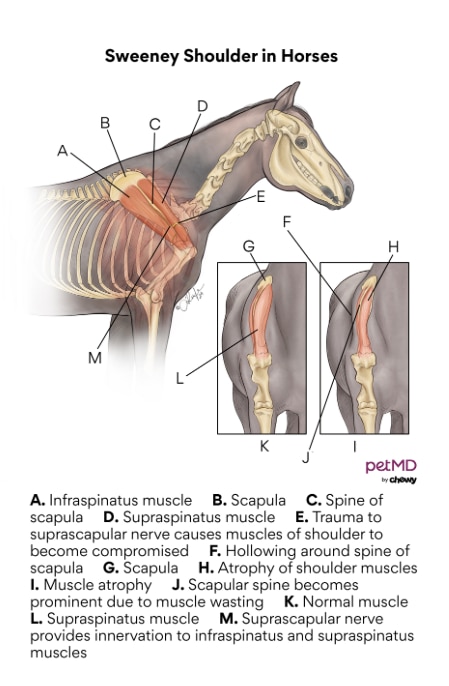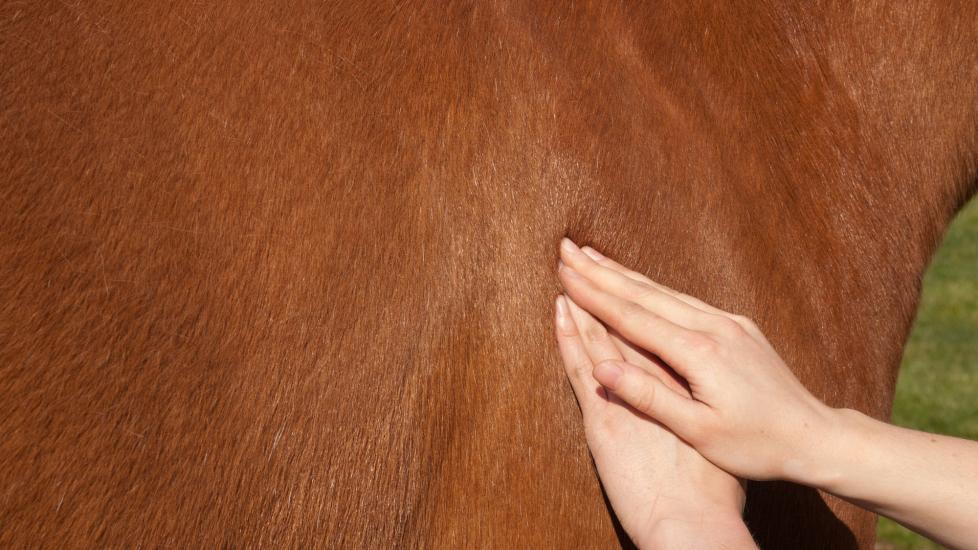Sweeney Shoulder in Horses
What Is Sweeney Shoulder in Horses?
Sweeney shoulder in horses, also called suprascapular neuropathy, is characterized by atrophy (wasting away) of the muscles of the shoulder of the horse.
Sweeney shoulder in horses is more commonly heard of today with horse owners than it was hundreds of years ago when a horse’s primary role was for transportation.

Click here to download this medical illustration.
During this time horses wore heavy harnesses to pull carts/buggies, and these harnesses would often pinch and bruise the suprascapular nerve against the horse’s shoulder blade, ultimately leading to muscle damage and muscle atrophy.
Symptoms of Sweeney Shoulder in Horses
The most common symptoms of sweeney shoulder in horses include the following:
-
Muscle wasting
-
Hollowing around the spine of the scapula
-
Scapular spine becomes prominent
-
Looseness of the shoulder joint or dislocation of the shoulder
-
Other muscles of the upper leg “wasting” away causing toe-dragging and shoulder “popping”
-
Inflammation
-
Reluctance to move affected leg forward
All cases of sweeney shoulder will show atrophy of the shoulder muscles. In severe cases, the muscle will disappear leaving the scapular spine prominent.
Causes of Sweeney Shoulder in Horses
Sweeney shoulder in horses is considered a syndrome because it describes the physical appearance of the horse's shoulder and not the diagnosis.
There are many causes that can lead to sweeney shoulder, but it most commonly occurs due to injury of the suprascapular nerve. The injury can happen acutely (like a kick to the shoulder) or due to a chronic injury (such as wearing a poorly fitting harness). The suprascapular nerve supplies important muscles of the shoulder with crucial connections. When they don’t function properly, the muscles can atrophy and not function properly.
Other causes of sweeney shoulder in horses include:
-
Disuse atrophy (not using the muscle)
-
Brachial plexus injury (generally affects several nerves and muscle groups starting from the neck, going down the shoulder and front leg)
-
Caudal cervical disease that results in spinal nerve radiculopathy (lower neck disease that results in pinching of the spinal nerves)
-
Lower limb injury or disease such as laminitis
-
Poor recovery from anesthesia—blood flow does not return to normal after a horse was lying down (reducing the blood flow to the tissues) from anesthesia or the drugs are still influencing the body
How Veterinarians Diagnose Sweeney Shoulder in Horses
Diagnosis of sweeney shoulder often includes a physical exam and radiographs (X-rays) to rule out a fracture of the forelimb or shoulder blade. On physical exam, the veterinarian will look for any muscle atrophy of the shoulder or changes in muscle mass compared to the other side. They may touch or observe if they can see the spine of the scapula which would be abnormal and due to muscle wasting.
The veterinarian may also want to watch the horse walk or check range of motion of the shoulder joint to evaluate any looseness of the joint. Radiographs (X-rays) may be important in some cases to help understand the severity of sweeney shoulder and decide on the treatment plan.
Treatment of Sweeney Shoulder in Horses
The initial treatment goal of sweeney shoulder is to reduce pain and inflammation for the horse. The horse will likely be on stall rest until the pain and inflammation are under control. This is important not only to get the horse more comfortable but also to encourage some controlled movement. Medications that may be prescribed by your primary vet include NSAIDs such as phenylbutazone (bute), Equioxx® (firocoxib) and Banamine® (flunixin meglumine).
Along with medical management, the horse’s muscles can be kept active through:
-
Physical therapy
-
Acupuncture
-
Chiropractic therapy
-
Electrostimulation
These methods can help to keep muscles active, encourage regeneration and limit further atrophy.
Once the horse is moving around more comfortably, the veterinarian may implement a controlled exercise program. Likely the controlled exercise program will consist of work on the ground such as lunging. As the horse progresses and is healing well, the exercise program may increase to controlled riding. This will be dependent on the severity of the injury and how the horse is healing.
Sweeney Shoulder Surgery in Horses
If severe atrophy or medical management is not showing improvement, surgery may be recommended.
A surgical procedure to remove part of the scapula bone and scar tissue may help to decompress the nerve and allow it to heal. Surgical treatment has an increased risk for scapular fracture as the bone is weakened, but the risk decreases as healing progresses.
Recovery and Management of Sweeney Shoulder in Horses
Recovery of sweeney shoulder is dependent on the cause and severity.
If nerve function is severely affected, the shoulder joint may become unstable and the joint may “pop out” as the horse bears weight on the shoulder. While this subluxation (partial dislocation) of the joint does not appear to be painful it does cause the joint to be unstable. This can significantly impact the long-term health of the shoulder joint and horse’s athletic career.
About 80% of horses with an injury to the suprascapular nerve will show improvement without surgical intervention. The majority of cases do appear to recover with time, but it can take up to 12 months for full function to return to the shoulder and some muscle loss will remain.
Prognosis of sweeney shoulder seems to be most affected by the following:
-
Duration of injury before diagnosis
-
Severity of muscle atrophy
-
Ability to perform physical therapy treatments for many months
Sweeney shoulder, with or without treatment, could lead to the following conditions:
-
Permanent muscle damage
-
Permanent nerve damage
-
Shoulder joint instability
-
Chronic lameness
-
Contralateral (opposite the leg affected by sweeney shoulder) limb laminitis
Sweeney Shoulder in Horses FAQs
Can a horse recover from sweeney shoulder?
Yes, a horse may recover from sweeney shoulder depending on the underlying cause, severity of atrophy, and duration of syndrome before treatment.
What causes a horse to be sweeney?
A horse may develop a sweeney shoulder due an acute or chronic injury to the nerve or from lack of use of the shoulder.
Featured Image: mikedabell/iStock / Getty Images Plus via Getty Images
